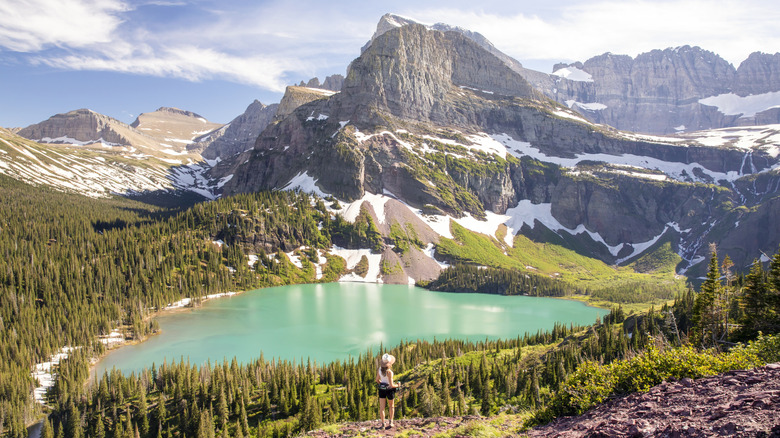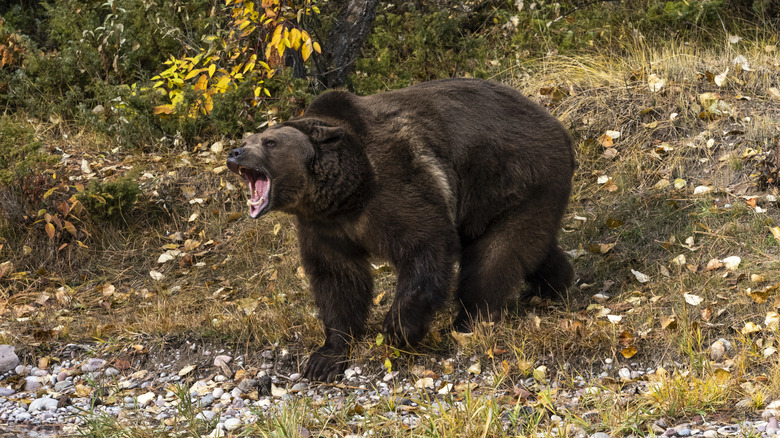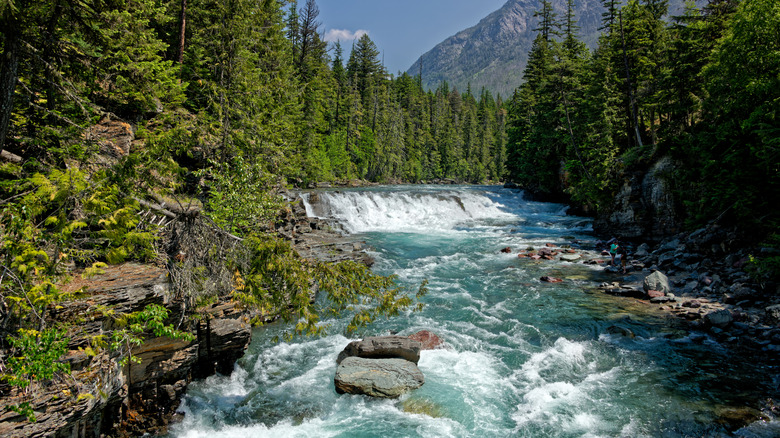This Iconic National Park Is Considered One Of The Most Dangerous US Camping Spots
We may receive a commission on purchases made from links.
Glacier National Park in Montana is on nearly everyone's national park bucket list. That is evidenced by the fact the park has seen close to three million visitors annually this decade. The popularity is due largely to the amount of outdoor recreational activities available within the national park, as well as the menagerie of wild animals living within its boundaries. This is also a last-chance tourism destination, as visitors flock to the park to catch a glimpse of its namesake glaciers before they disappear. However, it is considered one of the most dangerous U.S. camping spots — and not everyone who visits Glacier National Park makes it out safely.
Since its inception in 1910, Glacier National Park has seen a consistently high number of injuries and deaths. In its first century as a national park, 260 visitors were either confirmed or presumed dead. Just taking a look at the NPS Incident Reports between 1989-2024 shows how dangerous adventuring in this park is. According to the Great Falls Tribune, in 2022, Glacier National Park tied a record for most fatalities that year with seven.
A major reason for such a high rate of injury and death is what draws visitors to the park to begin with – outdoor adventure in rugged territory. While the most common cause of death within Glacier National Park is listed as natural causes, it can be argued these heart attacks and strokes are triggered by the rigorous nature of adventuring within the park. Beyond the natural causes, a litany of things have proven fatal to park visitors, ranging from slippery rocks to wild animal attacks to vehicular accidents. If you are planning to visit Glacier National Park, which is considered a must-see for most outdoor enthusiasts, you need to be aware of the risks before you go.
Dangerous creatures abound in Glacier National Park
Glacier National Park is renowned for its wildlife. However, while a number of these animals are majestic and awe-inspiring to look at, there are also a number of creatures to beware of when adventuring in Glacier National Park. At the top of that list is bears. Both grizzly and black bears live within the boundaries of the park. These massive mammals have been responsible for a number of attacks over the years that have led to visitors being injured or killed.
Bears are so prevalent in Glacier National Park, that oftentimes sections of the park and hiking trails are closed due to bear activity, as was the case following a grizzly bear attack in early autumn of 2024. With that in mind, you should always carry bear spray, such as a canister of SABRE Frontiersman, when adventuring in Glacier National Park. If you are overnighting, you need to make sure to avoid mistakes that attract bears to campsites and follow proper practices for cooking safely in bear country.
However, bears are hardly the only dangerous creatures in Glacier National Park. Mountain lions have also been responsible for a number of attacks. It is important to always keep an eye out for warning signs that a mountain lion may be near when hiking here. You should also know what to do if you encounter a wolf, wolverine, or moose. Although none of these animals is considered to be naturally aggressive towards humans, they are all capable of inflicting harm and have been known to attack in certain situations.
Perils go beyond wild animals
While attacks by grizzly bears and mountain lions may capture attention of the public, in actuality, they result in far fewer injuries and deaths than the natural elements of Glacier National Park. Next to natural causes, drowning and falling are the two most common causes of death within the park. The waters of the rivers and lakes of Glacier National Park not only claim drowning victims, they also result in a number of instances of hypothermia, as these waters are extremely cold even during the heat of summer.
The waters of the rivers and glacial lakes are also responsible for a number of falls and other accidents, as the rocks on the bottom are often moss-covered and slippery. Additionally, the river currents can be exceedingly strong. One other hidden danger of these waters is a parasite known as Giardia lamblia, which can cause diarrhea, nausea, and abdominal cramps. So, it is advisable to never drink the water from these lakes and streams without first boiling or filtering it with a device such as the LifeStraw personal water filter.
The mountains and steep cliffs within Glacier National Park also present the risk of falls. This is particularly true for hikers and climbers. A good number of people have taken a serious spill while attempting to get photos from either hiking trails or roadside observation spots. Snow and ice, which are common from late fall through spring, can add to the risk by making footing less sure and by obscuring potential pitfalls, such as deep crevasses. Heavy snowfall can also increase the risk of avalanches, which do occasionally occur. In fact, one of the park's deadliest incidents was an avalanche on Mt. Cleveland in 1969 which claimed the lives of five climbers


